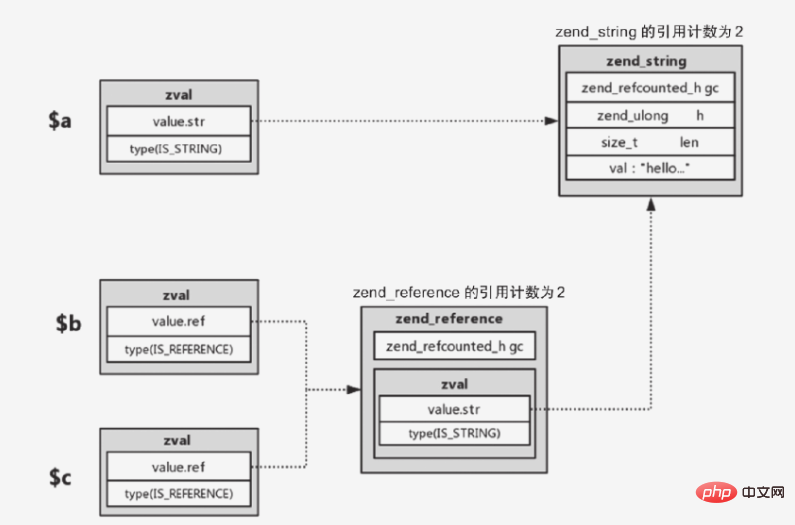What does gc mean in php
In PHP, the full name of gc is "Garbage Collection", which means "garbage collection" in Chinese. It is a dynamic memory management mechanism that automatically releases allocated memory blocks that are no longer needed by the program. The GC mechanism allows programmers not to worry too much about program memory allocation, so that they can devote more energy to business logic.

The operating environment of this tutorial: windows7 system, PHP7.1 version, DELL G3 computer
In php, the full name of gc is " Garbage Collection", which means "garbage collection" in Chinese, is a dynamic memory management mechanism.
The garbage collection mechanism (GC) automatically releases allocated memory blocks that are no longer needed by the program. The process of automatically reclaiming memory is called garbage collection.
The garbage collection mechanism (GC) allows programmers not to worry too much about program memory allocation, so that they can devote more energy to business logic.
Among the various popular languages now, the garbage collection mechanism is a common feature of the new generation of languages.
Generation of garbage
Complex types in PHP7, such as strings, arrays, objects, etc., have a gc in the header. The role of this gc It is used to support garbage collection. When a variable is assigned or transferred, the reference number of value will be increased. When the variable is released by unset, return, etc., the reference number will be subtracted. After subtraction, if the refcount is found to become 0, the value will be released directly. This is the basic recycling process of variables.
However, there is one problem that this mechanism cannot solve, which is the problem of circular references.
What is a circular reference? Simply put, the value stored inside the variable refers to the variable itself. This comparison often occurs with variables of array and object types.
Let’s talk about references first, that is, the zend_reference type. This is a new variable type in PHP7. When the "&" operation is used on a variable, a new intermediate structure zend_reference will be created. This structure will actually Points to the corresponding value structure.
For example:
// 当进行如下赋值操作时 $a = 'hello'; // $a -> zend_string $b = $a; // $b,$a -> zend_string $c = &$b; // $c,$b -> zval(type = IS_REFERENCE, refcount = 2) -> zend_string
will eventually become as follows:

That is, the zval of $b and $c passes through the middle The structure zend_reference then points to the final zend_string.
Back to the issue of circular references, here is an example of array circular references:
$a = [1]; $a[] = &$a; unset($a);
After using the & operation, variable a becomes a reference type and the reference count refcount is 2, and a value is assigned The element inside itself, that is, the variable a becomes a reference to itself.
The details are as follows:

After unset, it will become like the picture below:

That is, the zval type where $a is located has become IS_UNDEF. The reference count of the zend_reference structure is reduced by 1, but is still greater than 0. At this time, this part of the structure becomes garbage. If this is not processed, it will May cause memory leak. Here you need the garbage collector to collect this part into the buffer and then recycle it.
Recycling process
If the refcount of a variable is greater than 0 when it is reduced, PHP will not immediately perform garbage identification and recycling on this variable, but will put a In the buffer, after the buffer is full (10000 values), it will be processed uniformly. What is added to the buffer is the gc in the variable zend_value. Currently, garbage will only appear in two types: arrays and objects. In the case of arrays, As has been introduced, in the case of objects, the member attributes refer to the object itself. In other types, the members in the variables refer to the variables themselves will not occur, so garbage collection will only process these two types of variables.
The structure of gc zend_refcounted_h is as follows:
typedef struct _zend_refcounted_h {
uint32_t refcount; // 记录 zend_value 的引用数
union {
struct {
zend_uchar type, // zend_value的类型, 与zval.u1.type一致
zend_uchar flags,
uint16_t gc_info // GC信息,记录在 gc 池中的位置和颜色,垃圾回收的过程会用到
} v;
uint32_t type_info;
} u;
} zend_refcounted_h;A variable can only be added to the buffer once. In order to prevent repeated additions, zend_refcounted_h.gc_info will be set to GC_PURPLE after the variable is added, which is marked purple , will not be inserted repeatedly in the future.
The garbage buffer is a two-way linked list. When the buffer is full, the garbage checking process will be started: traverse the buffer, traverse all members of the current variable, and then reduce the refcount of the member by 1 (if the member is still If it contains sub-members, it will also be traversed recursively, that is, depth-first traversal), and finally the reference of the current variable will be checked. If it is reduced to 0, it is garbage. The core principle of this algorithm is: garbage is caused by members referring to themselves, then reduce the references to all members. If it is found that the refcount of the final variable itself becomes 0, it means that all its references come from its own members, that is, anywhere else. If you no longer use it, then it is garbage and needs to be recycled. Otherwise, it means it is not garbage and needs to be removed from the buffer. The specific process is as follows:
(1) Start traversing from the roots of the buffer linked list, mark the current value as gray (set zend_refcounted_h.gc_info to GC_GREY), then perform a depth-first traversal of the members of the current value, reduce the refcount of the member value by 1, and Also marked as gray;
(2) Repeatedly traverse the buffer linked list and check whether the current value reference is 0. If it is 0, it means it is indeed garbage. Mark it as white (GC_WHITE). If it is not 0, then It excludes the possibility that all references come from its own members, which means that there are external references and are not garbage. At this time, because step (1) decrements the refcount of the members by 1, it needs to be restored and a deep traversal of all members is performed. The member refcount is increased by 1 and marked in black;
(3) Traverse the buffer list again and remove non-GC_WHITE nodes from the roots list. In the end, all the roots list is real garbage. Finally, these garbage Clear.
Recommended learning: "PHP Video Tutorial"
The above is the detailed content of What does gc mean in php. For more information, please follow other related articles on the PHP Chinese website!

Hot AI Tools

Undresser.AI Undress
AI-powered app for creating realistic nude photos

AI Clothes Remover
Online AI tool for removing clothes from photos.

Undress AI Tool
Undress images for free

Clothoff.io
AI clothes remover

Video Face Swap
Swap faces in any video effortlessly with our completely free AI face swap tool!

Hot Article

Hot Tools

Notepad++7.3.1
Easy-to-use and free code editor

SublimeText3 Chinese version
Chinese version, very easy to use

Zend Studio 13.0.1
Powerful PHP integrated development environment

Dreamweaver CS6
Visual web development tools

SublimeText3 Mac version
God-level code editing software (SublimeText3)

Hot Topics
 1386
1386
 52
52
 PHP 8.4 Installation and Upgrade guide for Ubuntu and Debian
Dec 24, 2024 pm 04:42 PM
PHP 8.4 Installation and Upgrade guide for Ubuntu and Debian
Dec 24, 2024 pm 04:42 PM
PHP 8.4 brings several new features, security improvements, and performance improvements with healthy amounts of feature deprecations and removals. This guide explains how to install PHP 8.4 or upgrade to PHP 8.4 on Ubuntu, Debian, or their derivati
 How To Set Up Visual Studio Code (VS Code) for PHP Development
Dec 20, 2024 am 11:31 AM
How To Set Up Visual Studio Code (VS Code) for PHP Development
Dec 20, 2024 am 11:31 AM
Visual Studio Code, also known as VS Code, is a free source code editor — or integrated development environment (IDE) — available for all major operating systems. With a large collection of extensions for many programming languages, VS Code can be c
 7 PHP Functions I Regret I Didn't Know Before
Nov 13, 2024 am 09:42 AM
7 PHP Functions I Regret I Didn't Know Before
Nov 13, 2024 am 09:42 AM
If you are an experienced PHP developer, you might have the feeling that you’ve been there and done that already.You have developed a significant number of applications, debugged millions of lines of code, and tweaked a bunch of scripts to achieve op
 Explain JSON Web Tokens (JWT) and their use case in PHP APIs.
Apr 05, 2025 am 12:04 AM
Explain JSON Web Tokens (JWT) and their use case in PHP APIs.
Apr 05, 2025 am 12:04 AM
JWT is an open standard based on JSON, used to securely transmit information between parties, mainly for identity authentication and information exchange. 1. JWT consists of three parts: Header, Payload and Signature. 2. The working principle of JWT includes three steps: generating JWT, verifying JWT and parsing Payload. 3. When using JWT for authentication in PHP, JWT can be generated and verified, and user role and permission information can be included in advanced usage. 4. Common errors include signature verification failure, token expiration, and payload oversized. Debugging skills include using debugging tools and logging. 5. Performance optimization and best practices include using appropriate signature algorithms, setting validity periods reasonably,
 How do you parse and process HTML/XML in PHP?
Feb 07, 2025 am 11:57 AM
How do you parse and process HTML/XML in PHP?
Feb 07, 2025 am 11:57 AM
This tutorial demonstrates how to efficiently process XML documents using PHP. XML (eXtensible Markup Language) is a versatile text-based markup language designed for both human readability and machine parsing. It's commonly used for data storage an
 PHP Program to Count Vowels in a String
Feb 07, 2025 pm 12:12 PM
PHP Program to Count Vowels in a String
Feb 07, 2025 pm 12:12 PM
A string is a sequence of characters, including letters, numbers, and symbols. This tutorial will learn how to calculate the number of vowels in a given string in PHP using different methods. The vowels in English are a, e, i, o, u, and they can be uppercase or lowercase. What is a vowel? Vowels are alphabetic characters that represent a specific pronunciation. There are five vowels in English, including uppercase and lowercase: a, e, i, o, u Example 1 Input: String = "Tutorialspoint" Output: 6 explain The vowels in the string "Tutorialspoint" are u, o, i, a, o, i. There are 6 yuan in total
 Explain late static binding in PHP (static::).
Apr 03, 2025 am 12:04 AM
Explain late static binding in PHP (static::).
Apr 03, 2025 am 12:04 AM
Static binding (static::) implements late static binding (LSB) in PHP, allowing calling classes to be referenced in static contexts rather than defining classes. 1) The parsing process is performed at runtime, 2) Look up the call class in the inheritance relationship, 3) It may bring performance overhead.
 What are PHP magic methods (__construct, __destruct, __call, __get, __set, etc.) and provide use cases?
Apr 03, 2025 am 12:03 AM
What are PHP magic methods (__construct, __destruct, __call, __get, __set, etc.) and provide use cases?
Apr 03, 2025 am 12:03 AM
What are the magic methods of PHP? PHP's magic methods include: 1.\_\_construct, used to initialize objects; 2.\_\_destruct, used to clean up resources; 3.\_\_call, handle non-existent method calls; 4.\_\_get, implement dynamic attribute access; 5.\_\_set, implement dynamic attribute settings. These methods are automatically called in certain situations, improving code flexibility and efficiency.




